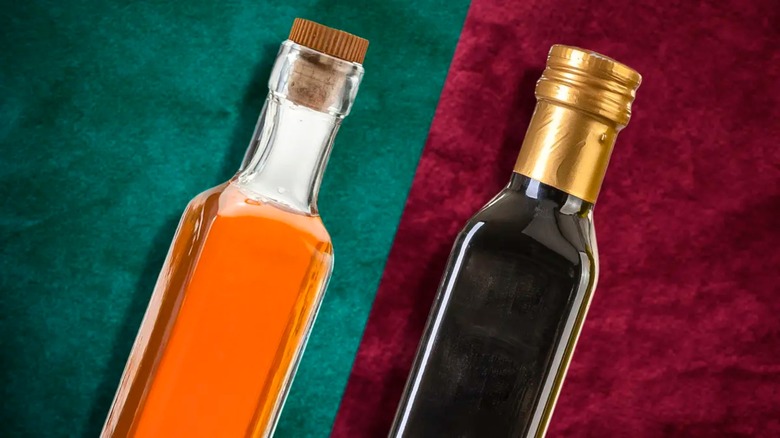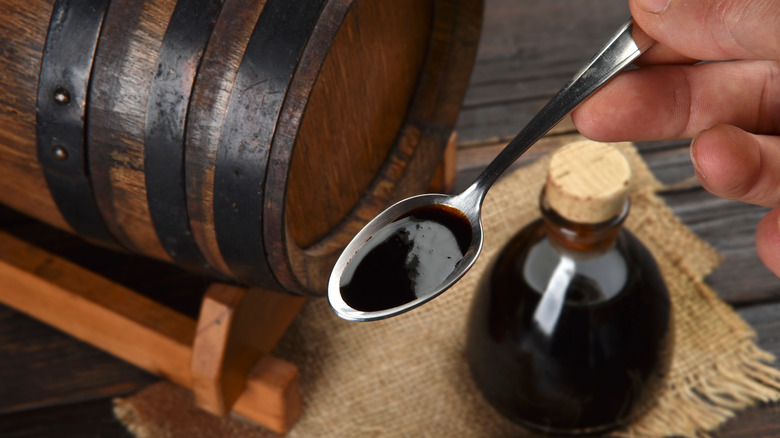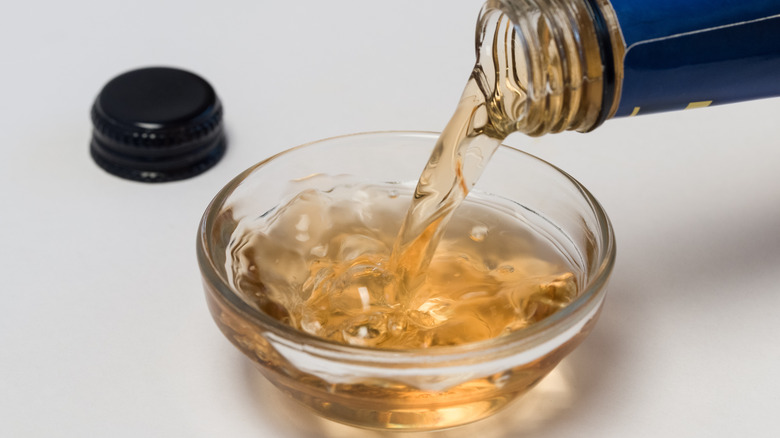Sherry Vs Balsamic Vinegar: How Do These Acidic Ingredients Compare?
Vinegar has been spicing up our lives through cleaning, cooking, and even medicinal uses for thousands of years. Every different type of vinegar starts out as a humble fruit, grain, or vegetable that goes through different fermentation processes that eventually leave us with the tart and tangy delight that we love. One of their defining features, acidity, might make it really easy to just chunk the different kinds of vinegar together, but every one of them has its own set of saucy nuances.
Take the balsamic and sherry varieties, for example. Balsamic vinegar contains at the very least 6% acetic acid. Sherry vinegar can have the same amount of acidity, although some brands crank it up to 9%. It may seem like there's not that much of a difference between these two ingredients, but there's actually a lot more to them than their acidity.
For instance, balsamic vinegar has a thick, rather treacly consistency as well as rich and sweet flavor profiles. Sherry vinegar is more like water in texture and offers sharper, more complex zings. Besides viscosity and taste, there are slight differences in the way that these tart ingredients are made and how we use them.
Balsamic vinegar: more sweet, less heat
Balsamic vinegar is perhaps one of the most popular vinegars to keep stocked in kitchens. Authentic versions hail from only two Italian destinations — Modena or Reggio Emilia. They are made with grape must, which includes the grape's juice, skin, and seeds that get crushed and ground to form a pasty liquid. The paste is then cooked low and slow, after which it is aged in an oak barrel for anywhere from 12 to 25 years. No wonder you can pay up to $200 for one bottle of this sweet stuff!
The taste profile will vary depending on how long balsamic vinegar has spent brewing in a barrel. Generally, balsamic is known for being darker, thicker, and less acidic than most other vinegar varieties. It is also sweet, fruity, and woody, whereas sherry varieties are less sweet.
Balsamic vinegar is rich and complex and spans the culinary spectrum, as it can be used in a number of different ways when it comes to cooking. It is generally not meant to be heated, as a high temperature can wreck its signature fragrance and flavor. This ingredient excels when used as a drizzle or dipping so that its taste can really be sampled thoroughly. Furthermore, it pairs perfectly with creamy desserts, fresh berries, and meats and seafood ready for serving.
Sherry vinegar: nutty notes and greater complexity
Sherry vinegar is not as popular as balsamic medleys, although it has its own set of attributes that make it a delightful vinegar to have in one's arsenal. As the name suggests, it is made from the fabulous fortified Spanish wine sherry. Authentic sherry vinegar, or Vinagre de Jerez, can only come from one place, and that's the Jerez region in southern Spain.
Sherry and its tart by-products are concocted through a "solera" system of blending, whereby different barrels of sherry from various years are combined, leaving us with a blended product that contains both young and aged versions. This fortified wine spends between six months and up to 40 years in an oak barrel to develop that sweet, oaky complexion we get with sherry vinegar. A "Reserva" label implies that it spent at least two years in a barrel, whereas a "Gran Reserva" label presents a vinegar that's been barrel brewing for over a decade.
The hues of this vinegar range from amber to mahogany, and it boasts a complex and slightly nutty flavor that's slightly sweet but not as sweet as its balsamic counterpart. It's fairly acidic but not as in-your-face as white wine vinegar may be. This is a full-bodied ingredient so you only need a little bit to go a long way. Sherry vinegars are ideal for vinaigrette in salads, glazes for meats, or simply any soup, stew, or sauce that needs a push of tang.


